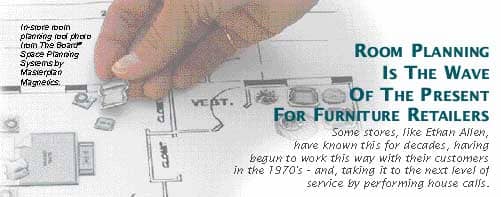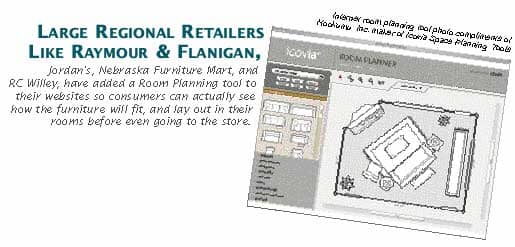There appears to be a new awareness among furniture retailers of the importance of furnishing new rooms vs. selling new products.
Editor’s Note: In keeping with the theme of this Trends/ Vision 2005 issue, Joe Capillo writes about an “awakening” among furniture retailers. Part 3 of his series on sales staffing and training will be published in the next edition of FURNITURE WORLD Magazine.
One of the advantages of having access to issues of FURNITURE WORLD Magazine going back to 1870 is that it is easy to pick up a back issue and read about changes (or lack of change) in our industry over time.
Visionaries such as Nat Ancell of Ethan Allen, Kay Lambeth of Erwin Lambeth and others were quoted in issues from the 1920s onward, as they urged industry executives to quit focusing on products, and to start thinking about more pressing consumer needs. With some exceptions, their advice has been ignored, until now, says Joe Capillo, with retailers starting to shift focus away from only products, prices and promotions.

Awakening
There appears to be a long overdue awakening among furniture retailers. For many years, industry visionaries who understand the deeper motivations of home furnishings shoppers have noted that our customers do not simply want more products to select from.
Furniture industry trends driven largely by manufacturers have led retailers to push an ever-expanding array of products. Most recently, the rush to promote one designer brand-name collection after another has accelerated -- as if consumers can't pick out good design on their own. We tell them that this or that designer has placed his or her stamp of approval on a line of furniture, so it's OK to buy it - it's a safe decorating choice. True, most of these collections contain well-designed furniture, but in many ways that's part of the long-standing industry problem.
Each furniture market witnesses a flood of new products from which store buyers can choose, but in all my years in this business, there have only been a few truly innovative introductions in the areas of motion furniture, home office, and, recently, entertainment furniture (driven by innovations in the electronics industry).
Research has shown that 40% of all furniture shoppers, in all categories, do not make a furniture purchase in the year they start to shop. Maybe, they don't make it at all - just continue to delay because, for many replacement purchases, there's simply no compelling reason to make an uncertain decision.

Many articles in FURNITURE WORLD Magazine have been written describing this phenomenon and citing failures by retail salespeople, managers and follow-up systems as root causes.
The real “uncertainty”, however, stems from the fact that what a piece of furniture looks like, or who designed it, or how much it costs, are not the most important factors driving consumers' purchase decisions. What is most important to her, is her room and the final outcome. It is not the specific furniture that matters most. It is this simple point of fact that describes our industry's long-standing disconnection from our consumers. We think it's all about furniture, when, in fact, it's all about rooms. So what does all this mean to home furnishings retailers?
Some retailers are moving in the right direction with this “room” thinking. Large regional retailers like Raymour & Flanigan, Jordan's, Nebraska Furniture Mart, and RC Willey (some pretty robust businesses there), have added a room planning tool to their websites so consumers can actually create a layout and see how the furniture will fit before even going to the store. Consumers are using these tools on the web, but I wonder if the same level of service is available to them in the stores? In some cases the answer is yes, in others, no. I have to ask why would you not want to provide this level of service to your customers in your store? How about all those consumers who didn't shop the web before visiting any stores?
Room planning is the wave of the present for furniture retailers. Some stores, like Ethan Allen, have known this for decades. They began to work this way with customers in the 1970's - and have taken their businesses to the next level by performing house calls. This service assures customers that their purchase is the right one, that delivers the desired solutions to the home decorating challenges she faces. Simple and straightforward - and it works.
If you are interested in investigating strategies and techniques for conducting house calls check the “sales skill index” on furninfo.com. There are a number of good articles by FURNITURE WORLD’s Contributing Editor, Cathy Finney.
Kitchen design firms have used CAD tools for decades to help consumers build their rooms. The technology has been around for a long time and this segment of the home furnishings business has acknowledged that consumers want this kind of help. Kitchen retailers have, therefore, made this kind of service a focus of their selling strategy. Without it, a kitchen design firm would just not be competitive. Furniture retailers have ignored this same, obvious consumer need. Instead, clinging steadfastly to the idea that it's all about product, promotion and price.
Many retailers will soon need to face the issue of strategic selling in order to ensure that their customers receive a higher level of service. Having a few salespeople on staff who choose to learn how to provide room design services will need to yield to a store-wide approach. Too often furniture retailers have left the strategy of selling entirely up to individual salespeople, resulting in a stew of selling styles and customer services ranging from very good to very poor. This has caused more lost sales than any other factor in our business. It's one primary reason why 40% of furniture shoppers can't make a decision about what to buy.
Room planning is the wave of today. Make sure you are prepared to ride this wave. You've got to think strategically about the sales side (the revenue generation side) of your business. Implement systems, not just ideas you talk about, but real systems that can be managed by you and your sales managers to achieve the results you, and your customers want.
Next Month
The ongoing series on sales metrics and sales staffing will resume with the April/May issue. It will include a discussion of how you should support and educate your new hires so that they can make an immediate positive contribution to sales and avoid disastrous consequences.